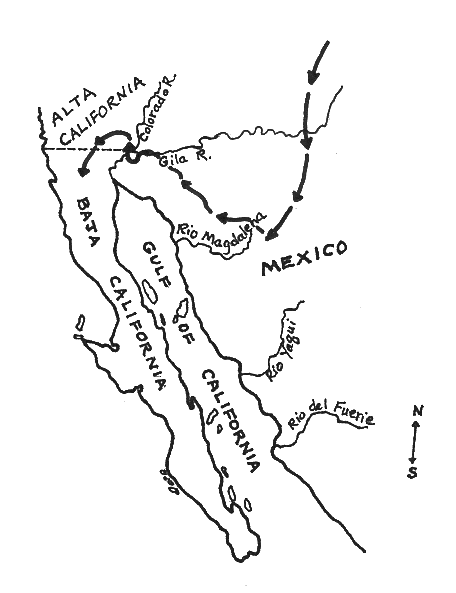| ||||
|
| ||||
|
MELCHIOR
DIAZ
 Lived:
in the 1500s
Lived:
in the 1500s
Explored California in: 1540
Exploring for: Spain
Explored: by land in the southern areas, west of the mouth of the Colorado
River
Melchior Díaz, a soldier in the army of New Spain, traveled across part of southern California in 1540. While Hernando de Alarcón, who went by ship up the Colorado River that same year, may have set foot on California soil, we know that Díaz journeyed about a third of the way across from the Colorado River to the Pacific Ocean. He was the first to take horses into what is now the State of California.
EARLY HISTORY
Melchior Díaz was born in New
Spain (
BACKGROUND
In 1540 Díaz was an aide to Francisco de Coronado and his army as they searched for the Seven Cities of Cibola, rumored to be cities of gold far to the north of Mexico City.
Coronado was in what is now New Mexico in the late summer of 1540. He had hoped to meet up with a supply ship under the command of Hernando de Alarcón, who was to come up the Colorado River from the Gulf of California. Since there had been no sign of the ship, Coronado decided to send Díaz in search of Alarcón and the supplies.
DIAZ’S JOURNEY
Díaz started west in late September 1540. With him were 25 men from Coronado’s army, all mounted on horses, and a group of Opata Indians from the Sonora Valley of Mexico. The Opata were good guides. They could understand the languages of the other Indians who lived near the Colorado River, and they were experienced in traveling in desert country. Díaz also took along a herd of sheep so they would have fresh meat on the journey.
Reaching the Colorado River
The Opata guided Díaz to the Gila River, which they followed downstream to where it flows into the Colorado River. This is where Alarcón had been just a few weeks earlier. Díaz named the big river the Río del Tizón (Firebrand River), not knowing that Alarcón had given it a different name.
The Indians here were much more frightened by Díaz and his group than they had been by Alarcón. Partly it was the horses, unknown to the Indians, that frightened them. Also, Díaz said he had been sent by Coronado to find Alarcón, and the Indians had heard how Coronado had killed many people. They told Díaz that Alarcón had gone back down the river.
Díaz hurried in pursuit, and after four days of traveling
downriver he found a tree where Alarcón had left a message. Now Díaz knew
that Alarcón had left the area and returned to
Into Alta California
When they found a place to cross, they built rafts of reeds. The rafts were wider in the middle and pointed at the ends. On these the men and sheep crossed the river, with the horses swimming along beside. They were now in Alta (Upper) California. It was December 1540.
History does not record exactly where Díaz crossed the Colorado River into California. It may have been near Yuma. At some point, however, Díaz may have gone as far up the Colorado River as present-day Blythe.
A Fatal Accident
After crossing the Colorado, Díaz headed toward the Pacific coast. Before reaching it, however, a terrible accident happened. A dog belonging to one of the soldiers was annoying the sheep. Intending to stop the dog, Díaz charged after it on his horse and threw his lance at the dog. The lance missed and stuck in the ground right in the path of Díaz’s horse. Díaz was seriously wounded as he fell on the lance.
At first it looked like Díaz was dead, but he soon roused, pulled the lance from his body, and bandaged his own wound. The men with him made a litter on which to carry him, and started back across the desert. They hoped to reach San Gerónimo de los Corazones in northern Mexico, but that was 500 miles away.
Walking as rapidly as possible, the group got back to the Colorado River and crossed it on the reed rafts. Then they headed south across the Sonora Desert. Díaz did not live to reach their destination. He died on January 18, 1541, twenty days after the accident. His men buried him there near “a little hill.” There was no marker for his grave, and the place is now unknown.
Two men who were with Díaz took the news of his death back to Coronado. It is from their report that the few facts about the explorations of Díaz are known.
WHAT HE ACCOMPLISHED
Díaz was the first European whom history records with certainty explored in what is today the State of California. He brought the first horses into California. Yet today there is little memory of his deeds, and no landmarks bear his name.